Search myodfw.com
This is a medium-sized bat with large, long ears. It is gray, brown, or black and generally active only after full darkness. Townsend's big-eared bat is very vulnerable to human disturbance, and its numbers are declining. In Oregon, it is classified as a State Sensitive Species. It's also an Oregon Conservation Strategy Species in all ecoregions except Nearshore. Never disturb this bat if you are in a cave. Photo by ©Michael Durham

This is a large, pale bat with huge ears, large eyes and a dog-like face. Its wing beat is slower than most bats. It emerges late at night to feed primarily on the ground, eating large beetles, crickets, and even scorpions. Pallid bats can walk on the ground and are immune to a scorpion’s sting. The pallid bat is uncommon and is found mostly in arid regions in canyons in southwestern and eastern Oregon. It's an Oregon Conservation Strategy Species in the Blue Mountains, Columbia Plateau, East Cascades, Klamath Mountains, and Northern Basin and Range ecoregions. Photo by ©Michael Durham

The Brazilian free-tailed bat is a fast-flying, medium-small bat with long narrow wings and a tail. It survives the cold winters in Oregon by staying in heated buildings instead of hibernating or migrating, often sharing these quarters with other bat species. Roseburg may be the most northern part of this bat’s range. Photo by ©Michael Durham

This group of mammals is spread nearly worldwide and in Oregon, they are found throughout the state. Oregon is home to the American pika and seven species of rabbits and hares.

The rat-sized American pika is characterized by rounded ears, no external tail, bare planter pads, and hind feed scarcely longer than the front feet. The pika requires talus, creviced rock, and other high elevation microhabitats that provide cool microclimates. Adequate forage close to rocky crevices is needed. In Oregon, the species is limited to suitable habitats in the Cascade Range and the Wallowa, Blue, Strawberry, Steens, Hart, and Warner mountains, and at Newberry Crater in Deschutes County and Grizzly and Cougar peaks in western Lake County. The American pika is an Oregon Conservation Strategy Species and is limited by its

The ears of the pygmy rabbit are short, rounded, and covered with long silky hairs inside and out; the tail is small and covered with hairs possessing wide buffy bands with narrow blackish tips above and below; and the feet are short, densely furred below, and colored a light orangy-buff. In Oregon, pygmy rabbits have been found east and south of a line connecting Klamath Falls, Fremont, Redmond, and Baker City. This rabbit is closely tied to habitats dominated by big sagebrush. The Pygmy rabbit is an Oregon Conservation Strategy Species in the Northern Basin and Range ecoregion. Photo from

The brush rabbit rarely ventures more than a few meters from the extremely dense brush that constitutes the requisite component of their habitat. Runways are interlaced through brushy clumps into surrounding grassy areas and are kept clear of vegetation for easy and quick access to and from foraging areas. In Oregon, the brush rabbit occurs in the Willamette Valley and other interior valleys, in coastal areas, and in valleys along coastal streams from the Columbia River south, and from the foothills of the Cascade Range west. Photo by ©Keith Kohl, ODFW

The eastern cottontail is the largest member of the genus in Oregon. Overall, the dorsal pelage is brownish, becoming darker (almost black) on the rump and lighter buffy brown on the flanks; the nape patch is orangy brown without black hairs, and the head is the same color as the dorsum. The hairs on the dorsum have steel gray bases followed by bands of brownish black, buff, and black. The venter hairs are white with gray bases, giving a splotched appearance when the hairs are spread, and the tail hairs are white to the base. This rabbit was introduced into

The mountain cottontail is intermediate in size and light grayish-brown in color. Its tail is white and ears relatively broad and rounded. It is usually associated with rocky outcrops with nearby dominant vegetation consisting of big sagebrush, bitter-brush, rabbit-brush, western juniper and mountain-mahogany. In Oregon, it occurs throughout the state east of the Cascade Range with a western extension into Josephine County. Photo by ©Keith Kohl, ODFW

The snowshoe hare is the smallest member of the genus in Oregon. Individuals in populations east of the Cascade Range, and some individuals in the Cascade Range, become white in winter and are brown in summer. This hare is associated with dense thickets of young conifers, especially those with lower branches touching the ground and especially firs and western larch interspersed with small clearings vegetated by grasses and forbs. Photo from ODFW

The black-tailed jackrabbit is slightly smaller than the white-tailed jackrabbit but considerably larger than the snowshoe hare. In conformation, it is much like the white-tailed jackrabbit. West of the Cascade Range, the dorsal hairs of this rabbit have gray blending to dark-brown or blackish base followed by a narrow band of buff and a black tip. Hairs on the throat, sides, and rump have gray bases blending to buff with short black tips. On the venter, hairs are white with light pinkish-buff tips. The tail is black on the dorsum and dark buff on the venter. The ears are dark
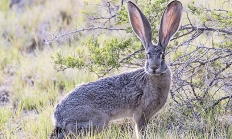
Summer and winter pelages of white-tailed jackrabbit are drastically different. In summer, the overall appearance is grizzled dark grayish with overtones of pinkish buff, blending lighter on the sides. In winter, it is the color of dirty snow, shading lighter on the sides. In Oregon, the white-tailed jackrabbit occurs east and south of a line connecting Rufus, Maupin and Antelope, John Day, Juntura, Fields, Fort Rock, and Fort Klamath and Klamath Falls. It is associated with bunchgrass habitats. The white-tailed jackrabbit is an Oregon Conservation Strategy Species in the Northern Basin and Range ecoregion. Photo by Wickipedia

The mountain beaver is a medium-sized, muskrat-like rodent often lacking a visible tail. It is not related to other beavers or rodents but are called beavers because of their habit of gnawing down young trees. The mountain beaver has an extremely short, fur-covered tail, and otherwise differs from the muskrat by possessing five-toed feet. It is dark brown with a small white spot at the base of each ear. In Oregon, are common in forested areas on the west slope of the Cascade Range west to the Pacific Ocean. They are, however, rarely seen as they spend most of their

The yellow-pine chipmunk is one of the smallest in Oregon, only slightly larger than the least chipmunk. Its face is marked with a dark stripe, followed laterally by two alternate light and dark stripes. The outermost light strip is nearly white. It occurs on the east slope of the Western Cascades and eastward through most of the remainder of Oregon, except it is absent from most of the Columbia Basin and much of southern Harney, eastern Malheur, and southern Baker counties. Its range also extends westward in the Siskiyou Mountains in southern Jackson and Josephine counties. Ponderosa pine seems to
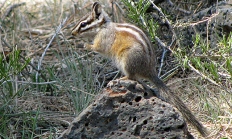
The least chipmunk is the smallest chipmunk in Oregon, but it is only slightly smaller than the yellow-pine chipmunk. As in all chipmunks, the face is marked with a dark stripe through the eye bordered on each side with a light- and a dark-colored stripe. The middorsum is marked with a dark-colored stripe followed on each side by two alternating light- and dark-colored stripes. The least chipmunk has the largest geographic range of any chipmunk. In Oregon, it occurs east of the Cascade Range except in the Columbia Basin and most of the Blue Mountains. In general, it is a
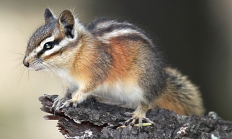
The pelage of this chipmunk is marked with five dark and four light stripes on the dorsum; the middorsal stripe is usually black and nearly always darker than the other four dark stripes. The sides of the face are marked with three brown and two light gray stripes, a patch behind the ear is light gray. The tail is blackish frosted with ochre dorsally and rusty brown ventrally. Allen's chipmunk produces a call of a rapid series of three or four to as many as 10 syllables. In Oregon, it occurs in forested areas along the eastern part of the
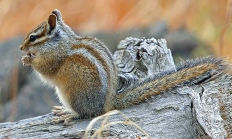
The Siskiyou chipmunk is slightly smaller than the Townsend's chipmunk and slightly larger than the Allen's chipmunk. The pelage is marked with five dark and four light stripes on the dorsum; the middorsal stripe is usually black and nearly always darker than the other four dark stripes. The sides of the face are marked with three brown and two light gray stripes; a patch behind the ear is light gray. It occurs in Curry, Josephine and Jackson counties south of the Rogue River; in extreme western Klamath County; in extreme eastern Douglas and Lane counties; and in extreme southeastern Linn
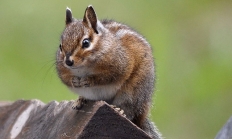
Townsend's chipmunk is the largest member of the genus in Oregon.The pelage of this chipmunk is dark and dull but as in other Oregon chipmunks, there is a dark brown to blackish middorsal stripe with alternate light and dark stripes, laterally, a total of five dark and four light stripes. Alternate dark (three) and light (two) stripes adorn the sides of the face. The throat, belly, and a patch behind the ear are white. The tail is black on the tip and the margins are frosted above with buff or white-tipped hairs. Townsend's chipmunks have been found on the west
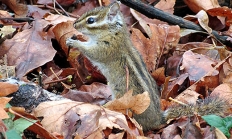
The yellow-bellied marmot is the largest squirrel in Oregon. It has short legs, a short and bushy tail, and ears short and covered with fur. The pelage consists of a dense, wooly underfur covered by long, course guard hairs and is distinctively colored and marked. In Oregon, it occurs in suitable habitats east of a line connecting Mt. Hood, Hood River County, and Mt. Mazama, Klamath County, except for the Columbia Basin. The primary requisites of suitable habitats for the yellow-bellied marmot are boulders or piles of rocks and an abundance of succulent vegetation in close proximity thereto. Occasionally, an
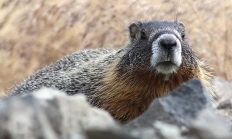
The white-tailed antelope squirrel is the smallest species of ground squirrel in Oregon. Although rather cryptically colored, it is marked distinctively: the grayish-brown dorsum and sides are separated by a white stripe on each side. The stripes are tapered at both ends and extend from behind the ear to near the base of the tail. A white line encircles each eye, the underside of the tail is white grading to grayish near the tip and the venter is white. In Oregon, it occurs south and east of a line connecting Vale, Malheur County; Harney Lake, Harney County and Paisley, Lake

